#WGSST2230
Text
Every Body Is Valid and Beauty Should Never be a Straight Jacket

This is a subject that deeply hits home for me. Representation of “plus-size” women and men in popular culture is something we’re beginning to hear much more about. As I write this I’m thinking about my own personal experiences as an “obese” child, and the downstream consequences it had for my life. Kids are cruel, but so is the world that shapes and incentivizes their behavior. I’ll spare the reader my life story, except to say that in my twenty-nine years, I’ve been diagnosed with anorexia and a couple of related eating disorders, body dysmorphia, have lost 125 pounds through methods no good for any body, and have seen the inside of a hospital room a time or two for symptoms related to it. In short, I know what it’s like to hurt intimately over my weight and body image. And as a male, I tend to be taken less seriously on opening up about it.
So when I see things like this, they really catch my eye. I absolutely love it. The person in this ad is authentic. She is unapologetically, defiantly wearing Calvin Kleins, staring the public directly in the eye. The look I see in her eyes (and I hope I’m correct) almost says “I dare you to be uncomfortable with this.” Having a 0-waist should never be a pre-requisite for validity. There is a damaging misconception floating around that people who are plus-sized or overweight are simply so because they lack self-control and/or are sedentary. But this simply is not the truth. Although lifestyle and tendency to be more or less active can influence this significantly, so many of us who hurt for our weight and self-image are incorrectly assumed to be lazy or gluttons. To have physical qualities that we cannot control, or at least not without the expense of our health, and have those qualities essentially disqualified from the culturally-restricted category “beautiful” can be a heartbreaking thing to live with and watch. But look at this ad. She’s wearing comfortable designer clothes. Images of people as they are shouldn’t be restricted to “before” photos. Sure, there will be plenty of people who scoff. Sling nasty little jokes at her expense or shake their head at the company’s decision. But she is visible. Visible as a manifestation of beauty. Personally, I’m over the moon to see this sort of inclusion in pop culture. “Skinny” is a highly hegemonic, potentially deleterious standard of beauty to force everyone to suffer to adhere to, and what’s more, those hegemonic images we have of what constitutes beauty are nowhere near a representative sample of the overall population.

(image copied from Google)
Before I close on this point, I want to mention the lack of plus-sized and overweight male protagonists and models as well. That type of exclusion is not specific to either sex. Here’s a quick true story: I once made the point to someone that all male protagonists in Disney and hero flicks were pretty much universally cut and muscular, or at least thin. Their one counter-example? Shrek.
I personally consider it an extremely important step forward to open up the stage to serious discussions of body image, and representation of the very real spectrum of body types.
2 notes
·
View notes
Text
Current State of Affairs: Time for Systemic Change

I’ll admit I was a little hesitant at first to broach this subject because of how massively polarizing it is. But in reality, that’s why we should be discussing it. If we don’t, nothing changes. In May of last year a man was murdered by police. By now we’re inundated with the graphic sidewalk and body cam footage, and the lengthy court proceedings that followed a year later. I don’t believe I need to recap any of the events.
Here is a telling indicator of the turbulence of current American culture: on January 6th a mob of - let’s call things what they are: domestic terrorists - converged on the capitol in protest of Donald Trump’s 2020 presidential defeat. They broke things, they stole a podium, they waved different flags (confederate included), and they clashed with and assaulted security officers. Let’s have a peek at how they were treated, shall we?
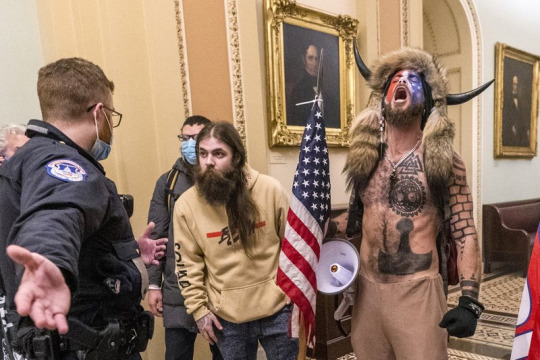
It seems like the officer in this photo kept a pretty cool head in the face of... whatever the guy on the right is doing. Reciting lines from Dances With Wolves, maybe? Notice anything about them? White guys across the board. Every one of these people got to go home. And yet in May of 2020, a Black man allegedly paid for his purchases at a gas station with a counterfeit twenty-dollar bill, and now we’re discussing his story posthumously. I’m pressed to think of a metaphor that does a better job of expressing the inequality that permeates all of this.
Again, I don’t believe we need a retelling of all the gory details, but everything was skewed from the beginning. The defense’s entire case relied upon convincing the jury - and the world - that the man who had been killed was simply a criminal, or on drugs, or (huge stretch coming up here) died of natural causes. That’s how we’re trained by the media to see Black and PoC community members. And what’s more, you could hardly spend any time at all online in the aftermath, scrolling through Twitter or Facebook, without seeing things about how “innocent people have nothing to fear” and “back the blue,” etc. And as heartbreaking as it is to see, this is hardly an isolated incident. In the last few years alone, we’ve seen examples that would indicate that as a Black person or person of color, one can’t even go the store for a pack of Skittles, walk through a park, forget to use a turn signal, or in some cases literally be asleep in their own bed, without fear of sharing Mr. Floyd’s fate, and then having the incident publicly defended. It’s unthinkable and indefensible. If this is the world many people truly intend to propose, then stop the ride because the rest of us want off.

And in this image we see a pivotal moment. The man responsible (importantly: one of the men responsible) is led away in handcuffs after a long-awaited verdict: guilty. I’ll be brief. This was the correct verdict, plain and simple. It is my utmost hope that by it, the Floyd family can find some semblance of peace, and Black and PoC communities at large may have an overdue indication that progress is happening and they will not be forgotten.
But I also hope that we remain focused on what’s most important - this is only one man. What’s truly broken is the system that employed, informed, and trained him. Of course, an overdue thing happened here, and I in no way wish to cheapen it. But it has to mean something with more longevity than a man. It’s my hope that those who, like me, agree with this guilty verdict, temper their celebrations in light of the fact that a battle has been won, but not yet the war. At the end of the day we still have on our hands one man dead and another awaiting sentencing. This man’s arrest is a display of accountability, but justice has to be farther-reaching. If we want to see real systemic change, we need to get at the real root of problem. Critically reshape the ways in which minority communities are represented in the media, and address disproportionate law enforcement responses between Caucasian and Black and PoC citizens.
0 notes
Text
Anti-Poor and Anti-Homeless Sentiments Are in the DNA of Our Culture
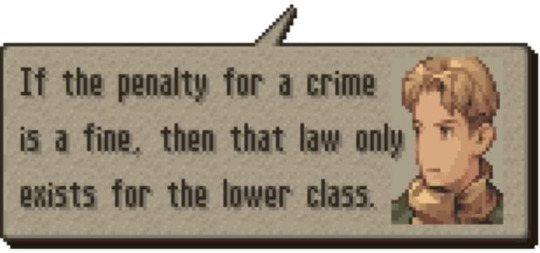
How is it that a single dialogue screen in a video game from the 1990s spouted off some social commentary that is so glaringly relevant in 2021? I came across this recently online and would have sworn someone made a meme using a quote from the 2020 presidential campaign designed to draw in young voters. But nope. This is a screenshot from an old Final Fantasy game. And there’s a reason it’s floating around now. Especially in the post-Covid world, we’re getting a clearer picture of the inequality inherent in our sociopolitical and economic climates. In essence, we’re seeing why a system that prioritizes the wealthy and wages war on the poor (and no, it’s not a war on “poverty” - it’s on the poor) can’t be sustained. A single perturbation to the system exacerbated things to the point of a full-on recession. Take the housing crisis for example. People who were already living paycheck to paycheck and choosing between groceries and rent, or childcare and insurance, have in the last year had their backs against a wall, under threat of eviction, repossession, fines, and incarceration - simply because they can’t work jobs that would put them at risk. And make no mistake, I am in no way advocating that someone who works for an hourly wage with the public should be left to suck it up and go to work - quite the contrary. What we have on our hands is a system of economic cruelty, imposed by the super-wealthy (a perfect example being landlords) in which our working classes are written off as expendable. As cannon fodder. And it doesn’t even begin to stop there.
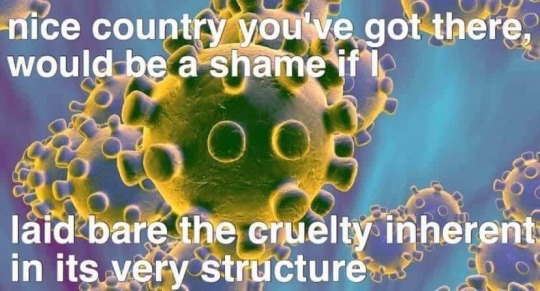
Anti-poor and anti-homeless sentiments are rampant in our culture down avenues that we would find shocking. You can even see it in the subtleties of architecture and corporate storefront designs. Have you ever gone down a walking path that ran under a bridge and seen something that looks a bit like this?:

Or maybe you’re driving down a busy street and you happen to pass a McDonald’s with this classic little fixture cemented outside:
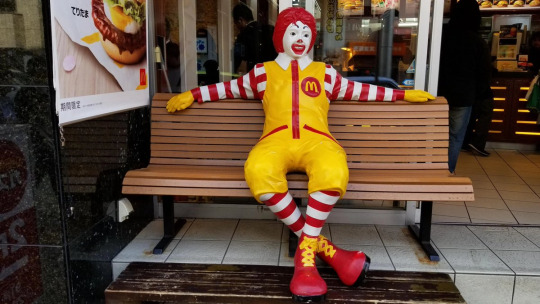
Guess who now, by design, doesn’t have a place to sleep because a corporate home office or city planner doesn’t want them cluttering up their space.
The point is that this isn’t new. The DNA of our entire economic culture grows from the perspective of “everything for the sake of profit.” Because the system itself is busted, we see things like the production of food not to sustain our hungry, but to make a profit. That’s why at the end of the night they throw away industrial-size trash cans full of perfectly edible food instead of distributing what they couldn’t sell. And let’s get ahead of it: this is not baseless speculation. I’ve worked a few different jobs in my time where I have seen this with my own eyes. In fact, I won’t say the name of the franchise, but I worked for one location as a teenager that banned two homeless twin brothers from coming in and using their restroom because they weren’t buying anything and were allegedly upsetting paying customers. ...Right.

So without realizing it, we’ve for a very long time been participants in a system that doesn’t lift up the poor and working classes - it punishes them. And what’s more, we subsequently hear these untenable defensive sentiments about how this helps to motivate people to “work harder” and “better themselves.” Because as everyone knows, Jeff Bezos worked 16-hour days at the quarry while putting himself through an Ivy League business school all through his twenties, right? Wrong. So even though from the outset you were at a massive disadvantage - born into poverty, disproportionately affected by unemployment or lack of education due to race, mental health issues, sexuality... it makes no difference to blind defenders of our hegemonic economic system.
We’re seeing enormous cultural and economic gaps where we need a massive overhaul. It’s past time to get on top of it.
0 notes
Text
Blatant Shaming Was an Effective Sales Tactic
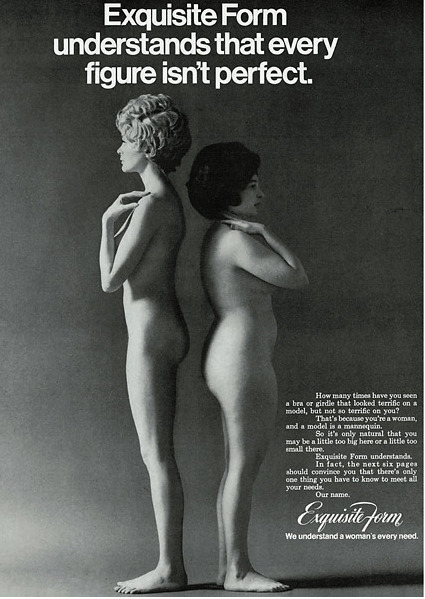
While doing some digging this week I came across this image of a classic advertisement for a women’s clothing brand. Some instances of vintage advertising are so blatantly sexist and hegemonic that it doesn’t seem like they could possibly be real. And yet, here we are. We have a company that inflated its success by capitalizing on the insecurities of the women to which they sold - and on the objectifying tendencies of many men that patronized the company for selfish, superficial gain. Exquisite form, in a very targeted way, exhibited two very real, valid, and normal female forms on in their advertisement, as examples of what not to be if you wanted to have, or to give the illusion of “a perfect form.” I would have a hard time designing a more glaring example of a cultural hegemonic standard than that. This company was borderline gloating about it, and simultaneously making money on it.
And the issue here doesn’t stop at what is blatant. Look at the very bottom line of text. “We understand a woman’s every need.” So not only had the company built a marketing campaign on making two examples of very normal body types seem inadequate, or flawed in some way and in need of repair, but they implied that there is an objectively verifiable set of needs a woman has - any woman - in order to obtain the “perfect” figure, and that they can make it happen.
Just pull apart the language of the ad. They weren’t even trying to hide it. “...you may be a little too big here or a little too small there.” What they were being made to feel about themselves was that too much or not enough, and this must have resonated powerfully with a great many women because these are quite normal, and of course perfectly valid body types. The language of the advertisement gets even more devious, to my mind, if you read between the lines. Not only is directly claiming that most common body types “need” a shape adjustment in order to be “perfect,” but it’s almost trying to soften the blow by saying “it’s okay, we understand.” - “That’s because you’re a woman, and a model is a mannequin, so it’s only natural...” They were trying to play both parts in a way that just strikes me as not only ignorant but evil. They were simultaneously breaking women down, then trying to look like godsends for being the ones to save or fix them.
How much better are we doing than this today?
0 notes
Text
Schitt’s Creek: David Rose as a Bridge to Normalization

I hope the world has gotten to give this masterpiece series - a family activity for the Levys - a watch all the way through. As I’m on the subject of inclusion in popular culture, this one jumped out at me. You see here David Rose, the son of a businessman, Johnny Rose, whose fortune was stripped away due to the malpractice of the person responsible for overseeing his business’s finances. The family’s saving grace? A small podunk town he had bought for his son as a joke at some point prior to the beginning of the series. It was the one asset they retained.
When you become immersed in a series, you follow protagonists’ character arcs and evolution closely (that is, you do if the series is worth its salt). As you follow them, learn about their lives, their conflicts, their successes, failures, loves, etc., you generally begin to relate to them and their experiences in some meaningful way. You should - otherwise, who was the character written for? The best are those with multi-dimensionality. You won’t relate to them in absolutely every way possible (I mean, probably not), but you likely will in some.
I introduce David Rose into my discussion of inclusion here because with him we are led to do exactly that. David is openly and unapologetically homosexual, and over time we see in him a complex protagonist who, albeit with some clearly fictionalized facets, has struggled in the same ways many of us viewers have. And that’s just it. That’s the beauty and the power of it. We can laugh with (and sometimes at), and in general feel with David, regardless of what our sexual orientation happens to be. Getting to know him on screen as a human being with depth who isn’t defined narrowly by his sexuality is an incredibly valuable thing, and one that is, as I mentioned previously, an example of the type of representation that will lead us to a de-stigmatization of homosexuality in our culture. The short of it is, David Rose is just a guy, and in his character we can see that being a gay man is a normal thing. Hopefully one day we’ll see the eventual erasure of hegemonic standards of love and intimacy that often make this risky to even discuss.

Case and point. Look at David and Patrick. Just as in my section on dating app advertisements, there is nothing in the world base or immoral about this image. There isn’t an iota of the lewd or pornographic to be found here. Although dressed in both comedy and tragedy for the sake of series tv, we just see two people who happened to be fortunate enough to find each other in a small, rural town.

0 notes
Text
Model Winnie Harlow as a Representation of Diverse Beauty Perception
Statistically, U.S. beauty standards significantly favor young, white, thin (often perilously so) women. From the tone of their skin to the color of their hair, lips, and eyes, down to their height, weight, frame and beyond, positive feedback seems to be skewed in their favor when compared with their counterparts in numerous other communities. Today media, and social media, are dominant forces in the beauty industry. Online influencers like Marlena Stell have online subscribers whose numbers reach millions, and the Internet opens up a space for two-way communication: Marlena produces content including makeup reviews and tutorials, her followers can subscribe, purchase, and review/comment, and she in turn can respond. Observation has revealed that white beauty influencers tend to gain a much more massive following than, for example, their Black or Latina counterparts. For answers to why this might be, we can begin by looking at market forces that drive this. Think, for example, about hair care product and makeup aisles at your local retail store that may feature products for African-American hair health and style on one end, but the rest of the lane and the other end are loaded with white-biased products. In this way, blind (or possibly not entirely blind?) market forces perpetuate and sell a hegemonic standard of beauty that ultimately presents an unjust disadvantage for Black and PoC customers.
BUT, there is hope yet for the growth of diversity in the beauty industry and culture. The image below is of Canadian-born model Winnie Harlow. Winnie is a fashion model with a skin pigmentation condition called vitiligo. She has also appeared on America’s Next Top Model and in several high-profile music videos. Her success should be celebrated for helping to move beauty standards toward inclusion of not only Black and PoC individuals (”onto the stages we built”), but also individuals with a unique outward phenotype - irregularities are not by definition antithetical to “beauty,” and her platform is one with the potential to illuminate hegemonic beauty standards so that they can at last be dismantled.
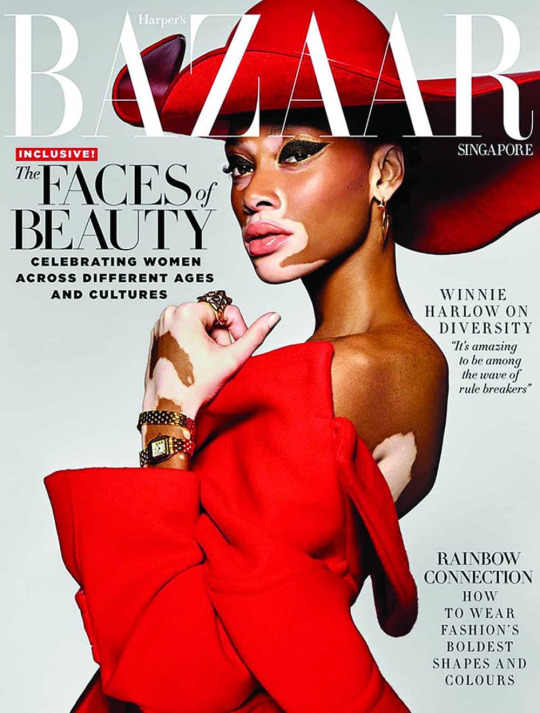
Images like this one should be empowering to women everywhere who have been made to feel like their “imperfections” by some destructive cultural norm somehow run antithetical to what “beauty” is. They do not. They should not. Think of the work of feminists from previous generations who were labeled as unattractive and rebellious or overly masculine simply for saying how they felt. How the standards they were held to just for being women were suffocating them.
I hope that Winnie’s example lights the torch for a multitude of others in need of their escape from an antiquated cultural sense of what “beauty” must be.
2 notes
·
View notes
Text
A Not-So-Subtle Shot at Body Image in Vintage Advertising
When it comes to standards of beauty, there is no denying that historically the scale has been wildly imbalanced in favor men. Specifically, straight, white, cisgender men. Classic advertisements for a myriad of products (many of which remain on the market even today in some form) take subtle shots at what is beautiful and acceptable about a woman (about the way she looks, dresses, presents herself, speaks, behaves... on and on). Some such attacks lack subtlety altogether, instead going straight for the jugular of positive self-image and confidence. As an example of the former, look over the Lucky Strike Cigarettes ad below. Not entirely subtle, right? But not entirely direct, either. If you look a little more closely at the text of the ad, you’ll see that the company discreetly slipped in a piece of language that reveals a much broader philosophy about standards of feminine beauty.
“Everyone knows that heat purifies and so 20,679 physicians say that Luckies are less irritating to your throat.”

Did you see it? The company didn’t say Lucky Strike cigarettes were healthy, or that they produced no irritation of the throat. They said Luckies are less irritating. Why is that important? The company was side-stepping a couple of sobering statements: (1) Smoking is harmful, but the word “irritation” is more palatable - especially since these cigarettes lead to less of that! (2) It’s worth the “irritation” Lucky Strikes produce over time to keep her slim-waisted, right? Her health (both physical and psychological) must be less important, secondary to making sure she maintains an unrealistic diver’s physique and markets this to generations as a beauty norm to which numerous young women and girls should aspire at the expense of their well-being. This, to me, represents a classic example of a hegemonic depiction of body image and oppressive beauty standards marketed to a generation as the status quo. As we have seen, for example in the authorship of people like Bell Hooks and Terah Stewart, the challenge of hegemonic influence runs deeper than just bad people. Bad ideas get themselves reproduced in a Darwinian fashion like a gene, a virus. If the environment suits them, they’ll multiply. Luckily, we as humans are uniquely positioned to intervene. We can “artificially select,” intentionally weeding out what is harmful or just plain wrong - much like the destructive standard pictured above.
A worth-while parting thought for this piece of history would be: how much better are we really doing now?
1 note
·
View note
Text
Laverne Cox and Scrapping Hegemonic Standards of Femininity and Beauty
While posting on this page, even though I’ve touched a couple of the negatives, I’ve tried to lean more heavily toward the positives. To celebrate what’s gone right more than ruing what’s gone wrong. Here I want to do a little more celebrating of representation. This example is going to touch on an overdue conversation we as a national are finally having.
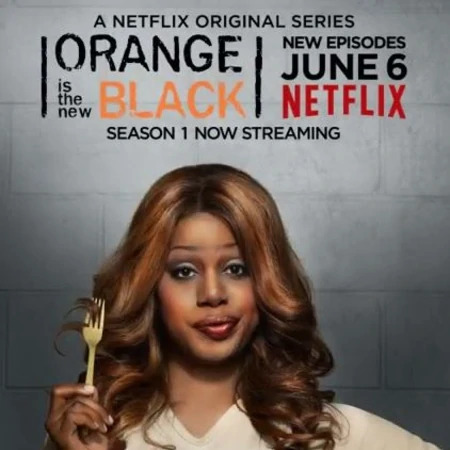
Laverne Cox was born male/assigned male at birth in Mobile, AL, where growing up she was harassed for not conforming to culturally archetypal roles for “men” and “women” / “boys” and “girls.” She openly discusses being chased, threatened, and even assaulted while coming up. Later in life, she has found success as an actress, and is using her platform to destigmatize the trans community and break through antiquated hegemonic conceptions of beauty.
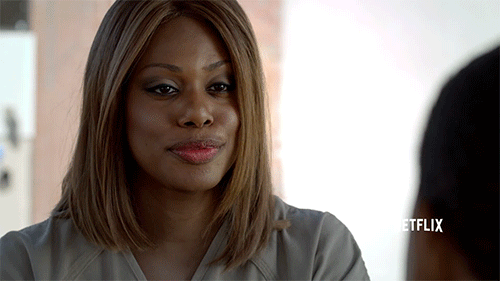
Cox is well known for her role in the Netflix series Orange is the New Black. In it she portrays Sophia, who we get to know both pre- and post-transition. She is incarcerated for stealing credit cards and using them to fund her transition. Her role in such a wildly popular series is important because it at last represents a community of people who have long been without a voice in media and pop culture. Without spoiling anything, her character arc in OITNB ends with her on the outside with a successful cosmetology career, the owner of her own salon! Throughout the series, we get to know Sophia as a living, breathing human being with valid concerns, fears, and family on the outside.
While reading about her life and career, I learned a super interesting thing about Laverne: her twin brother, musician and actor M. Lamar, plays the role of pre-transition Sophia on Orange is the New Black! Getting to know Laverne’s story as an outspoke activist for the inclusion and rights of the LGBTQ+ community, and the community-normalizing arcs of characters she plays like Sophia Burset, is a refreshing example of a breaking point from blind, culturally-hegemonic standards of what it means to be “feminine” or “beautiful.”

Keep on fighting, Laverne!
https://www.oprahmag.com/entertainment/tv-movies/a28987199/laverne-cox-facts/
0 notes
Text
Did We Grow Up on Classics that Promoted Hegemonic Beauty Standards?
This one is going to look familiar to most of us. The classics recreated by Disney were staples of so many childhoods (and adulthoods, depending on how nostalgic you’re feeling). But is it possible that we were being spoon-fed some painfully imbalanced standards of beauty and worth along gender lines? (I’ll just skip ahead for a second and say that yes, it is.) Looking back on the classics with some fresh, grown-up eyes we may notice some slightly (but not totally) subtle themes that blew by us as kids. For instance, there’s a glaring pattern of the “princess,” who is often a titular protagonist, having near-ubiquitous bust, waist, and hip dimensions. See it?
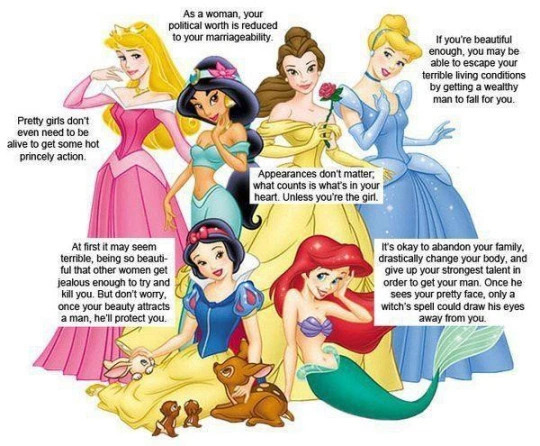
Each of the above also seems to have her canonical ills remedied by a common cure: a man. A wealthy man, a handsome man, a strong man, a virtuous man (not so much you on that last one, Sleeping Beauty) but the common denominator isn’t hard to spot. Cinderella, for example, escapes her living conditions with a makeover and a new rich husband. How likely is it that as kids, cues like these colored our perceptions later in life about what is truly beautiful and meaningful? (Again, yes.)

With women (and men) held to the unrealistic hegemonic standard that a super-thin waist and marriage prospects equal beauty, value, and success, what can we do to combat it? How can we release generations of women across race, age, and class lines from the claustrophobic box they’ve been placed in by dominant culture and the myriad media platforms that perpetuate and sell it to them?
We can start by looking it in the face and calling it what it is.
0 notes